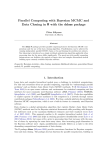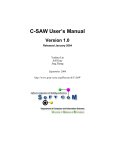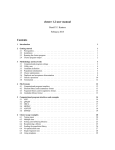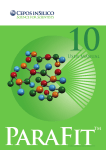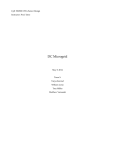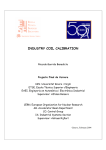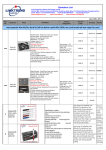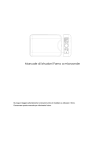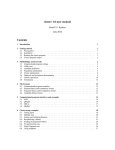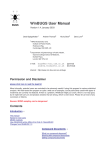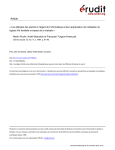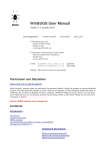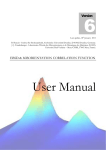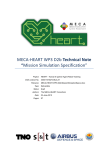Download "user manual"
Transcript
PolaBer Version 1.0 USER’S MANUAL 2014 AUTHORS: Anna Krawczuk Jagiellonian University [email protected] Piero Macchi University of Bern [email protected] Daniel Pérez University of Bern TableofContents 1. INTRODUCTION ..........................................................................................................................................3 2. LICENCE. ......................................................................................................................................................3 3. HOW TO OBTAIN POLABER. ....................................................................................................................3 4. HOW TO INSTALL POLABER. ..................................................................................................................3 5. ACKNOWLEDGEMENTS............................................................................................................................3 6. INPUT CARDS ..............................................................................................................................................4 7. 8. 6.1 Pre-calculations ......................................................................................................................................4 6.2 Files used and created by PolaBer ..........................................................................................................5 6.3 Control instructions – dipolar.inp ...........................................................................................................6 VIEWTENSOR ..............................................................................................................................................8 7.1 Control panel / general features ..............................................................................................................8 7.2 Moving the molecule ..............................................................................................................................8 7.3 Exporting files. .......................................................................................................................................9 Examples of input/output files ........................................................................................................................9 8.1 Control file: dipolar.inp ..........................................................................................................................9 8.2 Format and input requests necessary for entering PolaBer (if AIMAll not used). ...............................10 8.3 Output file – bond.out...........................................................................................................................11 1. INTRODUCTION PolaBer is a program which calculates atomic polarizability tensors from electric field perturbations of a partitioned electron density distribution. Among many possible partitioning schemes PolaBer is currently interfaced with software applying quantum theory of atoms in molecules. The calculation of the atomic tensors follows the idea by Keith1 that distributes over all atoms the intrinsic origin dependence of the molecular dipoles, thus increasing the possibility to export within chemical equivalent functional groups properties calculated from atomic dipoles, for example atomic polarizabilities. The software allows visualization of the tensors and calculation of straightforward optical properties of a molecule (like the molar refractive index) or a crystal (assuming the molecule in a given crystal lattice). 2. LICENCE. PolaBer is a free software. You can redistribute it and/or modify it under the terms of the GNU General Public License as published by the Free Software Foundation, either version 3 of the License, or (at your option) any later version. The software is distributed in the hope that it will be useful, but without any warranty; without even the implied warranty of merchantability or fitness for a particular purpose. See the Free Software Foundation, either version 3 of the License, or GNU General Public License for more details (http://www.gnu.org/licenses/). 3. HOW TO OBTAIN POLABER. The program is available on request from the authors in the form of a source code or can be downloaded directly from the web site http://www.macchi.dcb.unibe.ch Please do not use any output from the program without citation of the authors: Krawczuk, A.; Perez, D.; Macchi P. (2014) submitted please check in the future on www.macchi.dcb.unibe.ch/PolaBer.html for final publication details Please report any bugs by e-mail to: [email protected] or [email protected] 4. HOW TO INSTALL POLABER. On Windows XP/Vista/7/8 simply copy the folder contained in the compressed file on the PC and run viewtensor.exe (that could be linked to an icon on the desktop). For Linux platform, sources of the code are provided (only on request) and can be compiled using the makefile available (or modifying it according to the compiler available). PolaBer is written in Fortran90 and it requires an adequate compiler (for example gfortran). Lapack libraries must be installed as well. Static precompiled binaries are also available. 5. ACKNOWLEDGEMENTS. This work was done thanks to financial support from the Swiss Conference of Rectors (CRUS) and Swiss National Science Foundation (project Nr. 141271). 1 Keith, T.A. (2007) Atomic Response Properties in The Quantum Theory of Atoms in Molecules: From Solid State to DNA and Drug Design, Eds. Matta, C.F. & Boyd, R.J., Viley‐VCH, Weinheim. 6. INPUT CARDS 6.1 Pre-calculations Since polarizabilities obtained with PolaBer are numerical derivatives of the corresponding atomic dipoles with respect to applied electric field EF, following calculations have to be carried out before entering PolaBer: calculations of wave functions at zero electric field and small electric field, e.g. 0.005 a.u., directed towards X, Y Z, respectively. Example of a Gaussian input file: %chk=polar.chk %Nproc=12 #b3lyp/6-311++g(2d,2p) opt out=wfn B3LYP 6-31++G(2d,2p) H2O 0 1 O H H 0.000000 0.000000 0.000000 0.000000 -0.500000 0.500000 0.200000 -0.700000 -0.700000 zero.wfn --link1-%chk=polar.chk %Nproc=12 #b3lyp chkbasis nosymm scf=tight geom=checkpoint out=wfn field=x+50 x=50 0 1 xp.wfn --link1-.... --link1-%chk=polar.chk %Nproc=12 #b3lyp chkbasis nosymm scf=tight geom=checkpoint out=wfn field=z-50 z=-50 0 1 zm.wfn , Note: If you want to calculate crystal properties (i.e. refractive indices or rotatory power) following steps have be applied: 1. Export experimental fractional coordinates from a cif file to Cartesian 2. Keep nosymm command (when running Gaussian calculations) which will ensure no change in the definition of the coordinate system. 3. Input in PolaBer the unit cell (consistent with the coordinate setting) in order to compute crystal properties in correct form. PolaBer gives values of atomic polarizabilities in both fractional and Cartesian coordinate systems. integration of electron density after expanding the molecular density in terms of multipoles. At the moment PolaBer is compatible with AIMAll (Keith, 2013) and XD2006 (Volkov et al., 2006) software. In case of XD2006 the format of xd_pro.out file is not recognized by PolaBer, therefore additional external routine is used to extract necessary data. The routine xdread.exe is available with the main code and produces new output file readable by PolaBer. xdread.exe: input file: xd_pro.out (obtained for every wave function) output file: polaber.out Other software could be used, but a generalized input files has to be created by external software. The structure and contents of input file are given in Table 6.1. Table 6.1 Format and input requests necessary for entering PolaBer. Number of atoms: natoms At1 Atom label xyz Coordinates of At1 given in Å in Cartesian system Vol Atomic volume (calculated at ρ = 0.001 au) given in Å3 Q(A) Atomic charge Dipole Cartesian atomic unabridged moments given in Debeye/Å(l-1) Quadrupole Octupole Hexadecapole Number of bonds: nbond At1 At2 xyz rho delrho ellips d1 d2 xyz: coordinates of BCP in Å in Cartesian system rho: electron density on BCP delrho: Laplacian of electron density on BCP Ellips: bond ellipticity d1, d2: Distances between At1 and BCP and BCP and At2 given in Å in Cartesian system 6.2 Files used and created by PolaBer Input: dipolar.inp – control file *.sum – output files after integration of electron density when AIMAll software is used *.out – output files after integration of electron density when XD2006 package is used Note: Keep the format of input files as recommended. Output: bond.out – summary of calculations of atomic/bond polarizability bond.res – a crystallographic format, format the same as the one produced by SHELX program (Sheldrick, 2008). Instead of ADP’s, components of atomic polarizability tensors are given, scaled by the factor of 0.1 bond.x3d – file for visualization in a 3D scene with ViewTensor bond.x3draw – supporting file for visualization purpose 6.3 Control instructions – dipolar.inp INTEG WEIGHT VERBOSE n INTEG specifies which program was used for integration of electron density. Currently available AIMALL/XD WEIGHT if this keyword is present, weighting scheme will be used. Weighting scheme is used to avoid drastic changes of the shape and values of atomic polarizabilities caused by a presence of weak intra- and intermolecular interactions. PolaBer uses a weighting scheme which is inversely proportional to the bond strength measured by electron density at BCP: 1 | 1 | 1 VERBOSE n (n=0,1,2) setting n greater than 0 switches on extra printout to the output file (bond.out). By default n is set to 0. Nfiles Number of files to be read into PolaBer from AIMALL or XD software. nfiles= 4 if calculations were done for EFIELD=0, X, Y, Z nfiles= 7 if calculations were done for EFIELD=0, +/-X,+/-Y,+/-Z (highly recommended) fname1 … fname EFIELD EFX EFY EFZ EFIELD EFX EFY EFZ fname defines AIMAll (*.sum) or XD (*.out) filename with specification of applied electric field EFIELD. Example: If electric field is applied in X direction with the value of 0.005 au and integration of electron density was done with AIMAll software then: xp.sum EFIELD 0.005 0. 0. Note: Number of fname lines should be equal to nfiles. cell parameters a b c alpha esda esdb esdc esdalpha beta esdbeta gamma esdgamma Cell parameters given in Å and deg in fractional coordinates with their esds. LATT N LATT defines lattice type following SHELX convenction: N=1 – 7 1=P, 2=I, 3=Robv on hexagonal axes, 4=F, 5=A, 6=B, 7=C negative sign indicates non-centrosymmetric structure. SYMM x1 y1 z1 x2 y2 z2 x3 y3 z3, txt y tz SYMM specifies symmetry operations given by space group x1 y1 z1 - 1st row of rotation matrix x2 y2 z2 - 2nd row of rotation matrix x3 y3 z3 - 3rd row of rotation matrix tx,ty,tz -translational components in decimal notation +/- 0.25, 0.33, 0.5, 0.67, 0.75 Example: For space group P21/c SYMM SYMM TYPE SFAC UNIT 1 0 0 -1 0 0 0 0 1 0 1 0 0 0 1, 0 0 0 0 0 -1, 0 0.5 0.5 ntype C H O 10 10 10 Ntype defines number of atom types SFAC responds to scattering factors for each type of atom UNIT number of atoms of each type in a studied system, in SFAC order LAMBDA Gives a wavelength in Å ATOMLIST Nlist at1 at2 … If a keyword ATOMLIST is present, additional summary table for a chosen fragment will be created in bond.out. nlist gives a number of atoms to be included in a ATOMLIST table at1, at2 specifies atoms building chosen fragment which will be included in ATOMLIST table Note: controlling file dipolar.inp is case sensitive. 6.4 Running PolaBer To run a calculation with PolaBer open ViewTensor. Click on File and select Run PolaBer. After choosing a directory where all input files are present (*.sum/*.out and dipolar.inp), PolaBer will start the calculation of polarizabilities. When the calculation is finished, click on the button Done 6.5 Creating files for visualization To create a file for visualization purposes, click on File and select Convert Raw File. Program will ask you for opening X3draw file which is present in the directory where PolaBer calculations were done. After choosing the right file program will ask you to save new x3d file in a chosen destination folder. When clicking save ViewTensor will inform you that the file was converted and by clicking OK the program will open the x3d file. ViewTensor uses a default view where Z axis (Cartesian system) is directed towards the viewer. 7. VIEWTENSOR ViewTensor works on Windows platform and it is based on view3dscene by Kamburelis 2. It generates x3d file representing data in a 3D scene. Polarizability ellipsoids are represented in the same space as the molecule, assuming that 1Å31Å. To open x3d file choose File, select Open and then choose the directory you were working with. After opening the x3d file a graphical representation of atomic polarizabilities in a chosen system will appear. 7.1 Control panel / general features To open control panel choose View and select Control. This panel allows to configure bonds and polarizability ellipsoids in terms of style, thickness, radius and appearance. Available options on a control panel are explained in Figure 7.1. Most of the menu items intuition, but feel free to play around to find out more options. Figure 7.1 Screenshot of ViewTensor window. Some of the features are marked and explained in red. 7.2 Moving the molecule 2 Kamburelis, M. (2011) view3dscene(version 3.10.1), http://castle‐engine.sourceforge.net To rotate a molecule keep the left mouse button pressed and move it, the molecule will rotate about the X and Y axes. To rotate molecule around Z axis use the PAGE-UP / PAGE-DOWN button. To move molecule around press and hold the middle mouse button. By pressing and holding right mouse button zoom in and zoom out the molecule. Instead of using mouse buttons you can also use keyboard shortcuts. The list of available options is given in Table 7.2.1. To increase the speed of rotation of the molecule just hold longer control buttons. It is also possible to turn on/off the constant rotation about chosen axis. To turn on/off the constant rotation, press the Auto Rotation button on the Toolbar at the bottom of the ViewTensor window. By default Auto rotation is on. Table 7.2.1 Keyboard shortcuts used in ViewTensor. Key Function PAGE-UP / PAGE-DOWN rotate along Z axis Right/left arrow rotate along X axis Up/down arrow rotate along Y axis Space bar stop rotation HOME bring to default view +/- zoom in / zoom out; SHIFT + left mouse button move molecule around 7.3 Exporting files. To save image choose File -> Save Screenshot. Save dialog appears where you can choose the name of the file and directory where the image will be saved. Two types of file format are available: .bmp and .png. 8. Examples of input/output files 8.1 Control file: dipolar.inp AIMALL WEIGHT VERBOSE 0 7 zero.sum EFIELD 0. 0. 0. xp.sum EFIELD 0.005 0. 0. xm.sum EFIELD -0.005 0. 0. yp.sum EFIELD 0. 0.005 0. ym.sum EFIELD 0. -0.005 0. zp.sum EFIELD 0. 0. 0.005 zm.sum EFIELD 0. 0. -0.005 cell parameters 10.0000 10.0000 10.0000 90.000 90.000 90.000 0.0000 0.0000 0.0000 0.000 0.000 0.000 SYMM LATT TYPE SFAC UNIT 1 0 0 0 1 0 0 0 1, 0.0 0.0 0.0 -1 4 C H O 7 28 7 N 14 LAMBDA 0.71073 ATOMLIST 8 C1 O2 N3 H4 H5 N6 H7 H8 Format and input requests necessary for entering PolaBer (if AIMAll not used). For clarity only a part of input file is showed. ATOMIC CHARACTERISTIC AND PROPERTIES -----------------------------------ATOMIC COORDINATES GIVEN IN ANGSTROMS (ORTHOGONAL SYSTEM) ATOMIC VOLUME (V001) GIVEN IN ANGSTROM^3 CARTESIAN ATOMIC UNABRIDGED MOMENTS GIVEN IN DEBYE-ANGSTROM^(l-1) NUMBER OF ATOMS: 56 ATOM: N(3) xyz: VOL: Q(A): DIPOLE: QUADRUPOLE: OCTUPOLE: 0.00000000 17.82578394 -1.01695782 0.00972130 -7.78033540 0.00368600 -0.85917130 HEXADECAPOLE: -9.37016360 0.00082670 -1.31687130 H(4) xyz: VOL: Q(A): DIPOLE: QUADRUPOLE: OCTUPOLE: 1.16034000 -0.59564000 -0.15982950 0.00065970 -0.34784480 0.78791460 -0.00006320 -0.00036700 -0.04739350 0.08070210 -0.00196960 0.18410040 -0.27192870 -0.00300160 0.00024040 -3.11084100 2.02238000 -0.08434000 -0.36223760 -0.00069070 -0.16538950 -0.00657050 -0.00100170 0.00007560 -0.05053170 -0.19620990 -0.00034190 -0.09271780 -0.11580570 -0.00052070 -0.00020020 -0.32181300 1.18607000 -1.59730000 0.00641510 -0.00010950 -0.00497510 0.18702320 -0.00011150 0.00030770 0.01719780 0.47913380 0.00079940 0.21612140 -0.01012420 0.00110460 -0.00002530 -0.49905210 -5.77582780 0.00240460 -0.19784210 -2.18262190 -0.00389300 0.10526430 0.00040740 -5.49237610 0.00378830 -0.04014280 -3.94655010 -2.18257530 0.49898530 0.04358430 0.00010910 -0.41820410 -0.00071310 -0.02604890 -0.47754710 -0.12488950 0.00431420 0.00445130 0.00003160 -0.41887560 -0.00056480 0.00674700 -0.33535720 -0.19657160 0.04931750 ATOM: 0.00000000 4.87352353 0.37531402 -0.00364160 -0.45966470 -0.00246620 -0.34212350 HEXADECAPOLE: -0.35163640 -0.00055150 -0.13179050 -0.39501700 -0.00064220 -0.20846130 -0.16287390 -0.00037350 ... ATOM: H(5) xyz: VOL: Q(A): DIPOLE: QUADRUPOLE: OCTUPOLE: 0.00000000 5.47667135 0.30743514 -0.00428030 -0.53255160 -0.00290780 -0.04848880 HEXADECAPOLE: -0.42270140 -0.00016580 -0.16129540 -0.51349880 -0.00090850 0.37460970 -0.12941190 0.00040930 BOND CRITICAL POINTS -------------------xyz, d1, d2 GIVEN IN ANGSTROMS (CARTESIAN SYSTEM) rho, delrho GIVEN IN e-/ANG^x NUMBER OF BONDS: 7 --------------------------------------------------------------------------------------------BCP x y z rho delrho ellipticity d1 d2 ---------------------------------------------------------------------------------------------H(4) N(3) 0.000122 1.776164 -0.231975 2.220000 -23.660000 0.050000 0.287100 0.715200 ... H(5) N(3) 0.000090 1.176866 -1.301553 2.190000 -19.730000 0.050000 0.295900 0.706100 ... ---------------------------------------------------------------------------------------------- 8.2 Output file – bond.out For sake of clarity only a part of the output file is listed. ------------------------------------------------------------POLABER - A PROGRAM FOR ATOMIC POLARIZABILITY CALCULATIONS Anna Krawczuk; Daniel Perez; Piero Macchi (C) University of Bern Version 1.0 January 2014 ------------------------------------------------------------ATOMIC UNITS (A.U.) USED, EXCEPT WHERE STATED OTHERWISE UNIT CELL PARAMETERS (and e.s.d) -------------------a,b,c given in Angstroms -----------------------------------------------------------a b c alpha beta gamma 10.0000 10.0000 10.0000 90.0000 90.0000 90.0000 0.0000 0.0000 0.0000 0.0000 0.0000 0.0000 ------------------------------------------------------------ SYMMETRY OPERATION 1 0 0 0 1 0 0 0 1 0.00 0.00 0.00 ... SYMMETRY OPERATION 0 1 0 0.00 -1 0 0 0.00 0 0 -1 0.00 -----------------------------------------------------------WORKING ON: zero.sum NUMBER OF ATOMS: ---------------------NUMBER OF RINGS = 56 2 TOTAL ATOMIC DIPOLE MOMENTS --------------------------------------------------symbol x y z --------------------------------------------------C1 -0.00000641 0.00029283 -0.70279781 O2 -0.00062234 -0.00000027 -1.95720527 N3 0.00002975 0.29284280 -0.16332389 ... N54 -0.24388002 -0.00006970 -0.03027765 H55 -0.11705132 0.00004427 -0.05954688 H56 -0.00373060 0.00000049 0.00645011 --------------------------------------------------TOTAL MOLECULAR DIPOLE MOMENT ----------------------------x y z -0.00175771 0.00125971 -0.00964547 -----------------------------------------------------------... -----------------------------------------------------------WORKING ON: zm.sum NUMBER OF ATOMS: 56 NUMBER OF RINGS = 2 TOTAL ATOMIC DIPOLE MOMENTS --------------------------------------------------symbol x y z --------------------------------------------------C1 0.00005776 0.00011104 -0.67442148 O2 -0.00032053 0.00001327 -1.87197655 N3 0.00003513 0.27915152 -0.11798253 ... N54 -0.25511695 -0.00009536 0.00152691 H55 -0.11551872 0.00004165 -0.05721693 H56 -0.00365758 0.00000278 0.01721425 --------------------------------------------------- TOTAL MOLECULAR DIPOLE MOMENT ----------------------------x y z -0.00139372 0.00099155 1.41178403 ---------------------------------------------DIAGONALIZED ATOMIC POLARIZABILITY TENSORS IN CARTESIAN SYSTEM --------------------------------------------------------------alpha11, alpha22, alpha33 - Diagonal components of diagonalized atomic polarizability tensor alphaiso - Isotropic value of atomic polarizability -----------------------------------------------------ATOM alpha11 alpha22 alpha33 alphaiso -----------------------------------------------------C1 2.055 5.628 7.344 5.009 O2 5.137 11.425 16.960 11.174 N3 6.244 7.925 14.015 9.395 ... N54 5.573 6.383 14.374 8.777 H55 0.260 0.277 3.439 1.325 H56 0.442 0.588 2.244 1.091 -----------------------------------------------------ATOMIC PROPERTIES ----------------q(A) - Atom charge (EF=0) alpha11, alpha22, alpha33, alpha12, alpha13,alpha23 - Tensor components of atomic polarizability alphaiso - Isotropic value of atomic polarizability Vol - Atomic volume bounded by an isosurface of the electron density distribution (0.001 a.u.Isodensity Envelope, EF=0) ---------------------------------------------------------------------------------------------Atom q(A) alpha11 alpha22 alpha33 alpha12 alpha13 alpha23 alphaiso V ---------------------------------------------------------------------------------------------C1 1.695 2.055 7.344 5.628 0.003 -0.004 -0.002 5.009 33.611 O2 -1.259 11.425 5.138 16.960 0.012 0.005 0.001 11.174 118.607 N3 -1.081 6.244 12.856 9.085 0.001 -0.006 -2.391 9.395 116.292 ... N54 -1.099 13.532 6.383 6.415 0.010 -2.589 -0.002 8.777 118.174 H55 0.458 3.258 0.260 0.459 0.003 0.735 0.002 1.325 20.917 H56 0.359 0.615 0.442 2.217 0.000 -0.211 0.000 1.091 32.540 ---------------------------------------------------------------------------------------------MOLECULAR POLARIZABILITY TENSOR, AU^3 CARTESIAN SYSTEM -----------------------------------------------------------------------XX YY ZZ XY XZ YZ -----------------------------------------------------------------------236.850 224.479 285.006 0.054 -0.065 0.005 DIAGONALIZED MOLECULAR POLARIZABILITY TENSOR IN CARTESIAN SYSTEM --------------------------------------------------alpha11 alpha22 alpha33 alphaiso --------------------------------------------------140.026 203.713 402.596 248.778 -------------------------------------------------------------------------------------------------------------------------MOLAR VOLUME 3597.5104 MOLECULAR REFRACTIVE INDEX 1.3347 1.3512 1.4145 ------------------------------------------------------------------------ MOLECULAR RELATIVE PERMITTIVITY (dimensionless) 71.2907 For a calculation with polarizable continuum medium in G09 use the following instructions SCFR=(dipole,dielectric= 71.291,a0= 5.030) BOND PROPERTIES ----------------D(A-B) - Bond lenght of A-B in au d1 - Distance between atom A and BCP (EF=0) d2 - Distance between BCP and atom B (EF=0) d1 + d2 = Bond path (BP) rho - Electron density (EF=0) delrho - Laplacian of electron density (EF=0) elips - Bond ellipticity (EF=0) bcharge - Bond charge (EF=0) polA - Projection of polarizability of atom A on polB - Projection of polarizability of atom B on bondpol = polA + polB dipA - Projection of total dipole moment of atom dipB - Projection of total dipole moment of atom bonddip = dipA + dipB A-B bond A-B bond A on A-B bond B on A-B bond -----------------------------------------------------------------------------------------------------A-B D(A-B) d1 d2 rho delrho elips bcharge polA polB bondpol dipA dipB bonddip -----------------------------------------------------------------------------------------------------O2 C1 2.378 1.541 0.836 0.384 -0.910 0.076 -1.342 16.960 5.628 22.588 -1.957 -0.703 -2.660 N3 C1 2.538 1.511 1.027 0.344 -1.158 0.214 -0.176 13.955 6.875 20.829 0.335 0.369 0.704 N3 H5 1.884 1.402 0.438 0.356 -1.993 0.043 -0.446 9.014 2.591 11.605 -0.159 -0.091 -0.250 ... H53N51 1.884 0.469 1.374 0.356 -1.804 0.056 0.361 2.512 6.728 9.240 0.005 -0.039 -0.034 N54H55 1.900 1.424 0.432 0.347 -1.971 0.046 -0.481 9.557 3.203 12.760 -0.227 -0.131 -0.358 H56N54 1.884 0.469 1.373 0.356 -1.802 0.053 0.359 2.210 6.339 8.549 0.006 -0.034 -0.028 -----------------------------------------------------------------------------------------------------ATOMIC POLARIZABILITIES FOR CHOSEN FRAGMENT ------------------------------------------------------------------------------------Atom alpha11 alpha22 alpha33 alpha12 alpha13 alpha23 alphaiso ------------------------------------------------------------------------------------C1 2.055 7.344 5.628 0.003 -0.004 -0.002 5.009 O2 11.425 5.138 16.960 0.012 0.005 0.001 11.174 N3 6.244 12.856 9.085 0.001 -0.006 -2.391 9.395 H4 0.293 3.507 0.673 0.007 -0.006 0.980 1.491 H5 0.300 0.725 2.586 -0.004 -0.006 0.180 1.203 N6 6.243 12.852 9.073 -0.004 0.001 2.406 9.389 H7 0.301 3.512 0.678 0.007 0.003 -0.971 1.497 H8 0.303 0.730 2.584 -0.002 -0.002 -0.179 1.205 ------------------------------------------------------------------------------------TOTAL POLARIZABILITY TENSOR OF A CHOSEN FRAGMENT, CARTESIAN SYSTEM, AU^3 -----------------------------------------------------------------------XX YY ZZ XY XZ YZ -----------------------------------------------------------------------27.162 46.662 47.267 0.021 -0.015 0.024 ------------------------CRYSTAL PROPERTIES ------------------------NUMBER OF ATOMS IN THE UNIT CELL 16 FRACTIONAL COORDINATES OF ATOMS IN THE UNIT CELL -------------------------------------------symbol x y z -------------------------------------------C1_1 0.0000 0.5019 0.3291 O2_1 0.0000 0.5019 0.5978 N3_1 0.1452 0.6471 0.1788 H4_1 0.2562 0.7580 0.2852 ... H5_3 0.6452 -0.1433 0.0340 N6_3 0.3566 0.1452 -0.1788 H7_3 0.2457 0.2562 -0.2852 H8_3 0.3585 0.1433 0.0340 -------------------------------------------- NOTE: Atoms are kept in order to form regular molecules and they do not necesssarily lie in the unit cell 0 < x < 1; 0 < y < 1; 0 < z < 1 ATOMIC POLARIZABILITIES IN THE UNIT CELL, FRACTIONAL SYSTEM, ANG^3 ------------------------------------------------------------------------Atom alpha11 alpha22 alpha33 alpha12 alpha13 alpha23 ------------------------------------------------------------------------C1_1 0.685 0.703 0.886 0.385 0.006 0.005 O2_1 1.220 1.226 2.588 -0.463 0.011 0.010 N3_1 1.403 1.416 1.362 0.484 -0.258 -0.261 H4_1 0.278 0.285 0.099 0.235 0.097 0.099 ... H5_3 0.078 0.079 0.394 -0.031 -0.022 0.024 N6_3 1.429 1.401 1.359 -0.489 -0.270 0.274 H7_3 0.293 0.273 0.092 -0.237 0.094 -0.088 H8_3 0.078 0.077 0.394 -0.030 0.022 -0.019 ------------------------------------------------------------------------CRYSTAL SUSCEPTIBILITY CHI 0.9453 0.0000 0.0015 0.0000 0.9453 0.0064 0.0015 0.0064 1.2416 CRYSTAL DIELECTRIC CONSTANT EPSILON 1.9453 0.0000 0.0015 0.0000 1.9453 0.0064 0.0015 0.0064 2.2416 REFRACTIVE INDICES n1 < n2 < n3 n1 n2 1.3947 1.3947 n3 1.4972 positive UNIAXIAL OPTICAL INDICATRIX BARICENTER OF MOLECULES IN UNIT CELL (FRACTIONAL COORDINATES) Symm. Nr. X Y Z _1 0.5000 0.0000 0.2736 _3 0.0000 -0.5000 -0.2736 Please note that the selected molecules may not be within 0 < x < 1; 0 < y < 1; 0 < z < 1 LORENTZ CORRECTION: ALFFA TYPE CRYSTAL SUSCEPTIBILITY CHI 1.1315 0.0000 0.0012 0.0000 1.1315 -0.0003 0.0012 -0.0003 1.5264 CRYSTAL DIELECTRIC CONSTANT EPSILON 2.1315 0.0000 0.0012 0.0000 2.1315 0.0000 0.0012 0.0000 2.5264 REFRACTIVE INDICES n1 < n2 < n3 n1 n2 1.4600 1.4600 n3 1.5895 positive UNIAXIAL OPTICAL INDICATRIX ------------------------------------RIGOROUS LOCAL FIELD THEORY Lorentz Tensor Total 0.3239 0.0000 0.0000 0.3239 0.0000 0.0000 Lij Trace = 0.0000 0.0000 0.3521 1.0000 ----------------------------------CALCULATION USING MOLECULAR POLARIZABILITIES CRYSTAL SUSCEPTIBILITY CHI 1.1196 0.0000 0.0000 1.1196 0.0012 -0.0003 0.0012 -0.0003 1.5715 CRYSTAL DIELECTRIC CONSTANT EPSILON 2.1196 0.0000 0.0012 0.0000 2.1196 0.0000 0.0012 0.0000 2.5715 REFRACTIVE INDICES n1 < n2 < n3 n1 n2 1.4559 1.4559 n3 1.6036 positive UNIAXIAL OPTICAL INDICATRIX
















